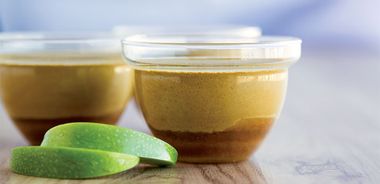Apple Caramel Pumpkin Pie Panna Cotta

Look no further for a new twist on a fall favourite! All the goodness of pumpkin pie has been transformed into a cool and refreshing pudding. The bottom layer is tart apple caramel topped with rich creamy pumpkin.
Caramel
4 cups (1 L) unfiltered apple juice 1 Tbsp (15 mL) coconut oil or butter 1/4 tsp (1 mL) vanilla extract
Panna Cotta
3 Tbsp (45 mL) cold water 2 1/2 tsp (12 mL) powdered gelatin or 3 Tbsp (45 mL) agar agar 2 cups (500 mL) coconut milk or homogenized milk 2 Tbsp (30 mL) molasses 3/4 cup (180 mL) pumpkin, sweet potato, or squash purée 1 tsp (5 mL) ground cinnamon 1/2 tsp (2 mL) ground ginger 1/4 tsp (1 mL) ground nutmeg
To make caramel sauce, pour apple juice into medium saucepan. Bring to a boil, then reduce heat. Simmer, stirring occasionally, until juice foams and turns deep amber, about 35 to 40 minutes. Remove from heat and stir in coconut oil and vanilla. You should have about 1/2 cup (125 mL) sauce. Divide mixture among 8 ramekins, thick glasses, or coffee cups. Refrigerate to set while preparing panna cotta.
To make panna cotta, pour cold water into 4 cup (1 L) measuring cup or medium bowl. Sprinkle gelatin over top. In saucepan, stir milk with molasses. Place over medium heat, stirring often, until hot. Remove from heat and whisk in pumpkin and spices. Gradually pour into measuring cup with gelatin and whisk to blend.
Remove ramekins from fridge. Divide pumpkin mixture over top. Refrigerate until set, at least 6 hours or overnight.
Serves 8.
Each serving contains: 234 calories; 3 g protein; 16 g total fat (14 g sat. fat, 0 g trans fat); 23 g total carbohydrates (17 g sugars, 2 g fibre); 20 mg sodium
Substituting agar agar for gelatin
In saucepan, stir agar agar with milk and molasses. Let stand for 15 minutes, then bring to a gentle boil, stirring to dissolve. Remove from heat and continue with recipe.
source: "Naturally Sweetened Deserts", alive #385, November 2014




